On Whitman’s Hill (grid reference SO748483) is a disused limestone quarry which allows us to see excellent geological exposures of mudstones, limestones and thin volcanic ash bands of Silurian age (about 425 million years old – or 425Ma). The mudstones and limestones are rich in the fossilised remains of Silurian sea creatures such as brachiopods, trilobites, corals, crinoids, bivalves and cephalopods.

During the Silurian period, the surface of the Earth looked very different from today. Britain as we know it did not exist. An area of land that now makes up most of Wales and England was located approximately 30° south of the equator. The geography of the time is shown in the picture on the left (by courtesy of Dr Ron Blakey, Department of Geology, Northern Arizona University). The present national boundaries are shown and the position of southern England is marked by an arrow. This land was covered in warm, shallow seas, in which all the creatures lived – it was quite like the Seychelles or the Bahamas today.
Rivers flowing from distant land to the east carried muds and silts which built up in the sea, eventually forming the mudstones of the 'Coalbrookdale Formation', the
oldest rocks we see at Whitman’s Hill. There was then a long period when mainly lime was deposited in the seas and
small reefs (known as 'bioherms') sometimes formed – these deposits formed the limestones of the 'Much Wenlock Limestone
Formation'.
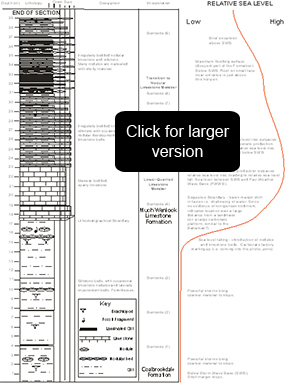 Some of these limestones are full of lumpy nodules, earning them the local name of 'Storridge Porridge'.
Both the mudstones and limestones are full of fossils. At this time, volcanoes were also regularly erupting in the area.
We know this because thin layers of volcanic ash ('bentonites') are found between the rock layers at Whitman’s Hill.
A technical description of the rock layers in the quarry is summarised in the stratigraphic log, shown to the right.
The boundary between the mudstones of the Coalbrookdale Formation and the Much Wenlock Limestone Formation is not evident at first sight on the quarry face. It has been determined by the detailed stratigraphic work.
Some of these limestones are full of lumpy nodules, earning them the local name of 'Storridge Porridge'.
Both the mudstones and limestones are full of fossils. At this time, volcanoes were also regularly erupting in the area.
We know this because thin layers of volcanic ash ('bentonites') are found between the rock layers at Whitman’s Hill.
A technical description of the rock layers in the quarry is summarised in the stratigraphic log, shown to the right.
The boundary between the mudstones of the Coalbrookdale Formation and the Much Wenlock Limestone Formation is not evident at first sight on the quarry face. It has been determined by the detailed stratigraphic work.
Volcano!
Thin layers of volcanic ash, known as 'bentonites', are found throughout the sequence of rocks at Whitman’s Hill. They are generally a centimetre or two in thickness and are white in colour when freshly exposed. Their positions in the rock section can be seen on the stratigraphic log. We know from these bentonites that volcanic ash rained down on this tropical sea nine times, probably killing most of the sea creatures each time. We don’t yet know the location of the volcano (or volcanoes) but we have used crystals of apatite (see crystal image, Fig.1, below, which is greatly magnified, this crystal is actually about 0.25mm long) found in some of these bentonites to tell us more about the types of magma that came out of them.
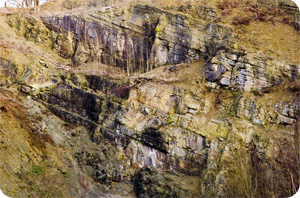
We now know that some of the older bentonites came from one type of magma (acid) whilst the youngest bentonite, at the very top of the exposure at Whitman’s Hill, came from a less evolved magma (with a more mafic / intermediate composition). This suggests that different volcanoes were responsible for the different ash layers. We have also worked out how old the bentonites are, telling us the approximate age of the rocks at Whitman’s Hill. Zircon crystals (see crystal image, Fig. 2, below, which is actually about 0.1mm long) in the bentonites at Whitman’s Hill contain the radioactive element uranium, which decays at a known rate, eventually forming lead.
By working out the ratio of uranium to radiogenic lead in the zircon crystals, we have been able to confirm the age of the rocks in this quarry as being around 425 million years old. Although the types of rocks and fossils found here give us a relative age (e.g. the Wenlock series, which is within the Silurian period), only the presence of these radioactive elements, such as uranium, which are not present in mudstones and limestones, can help us to work out the exact age of the rocks. The bentonites at Whitman’s Hill are therefore very important. (For more technical information, see 'Analysis of the Bentonites' below.)
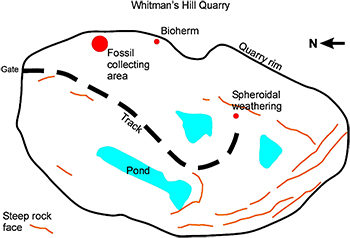
Bioherm
Whitman's Hill is an important locality because preserved here is a bioherm, a fossil reef. This lens-shaped structure (about four metres across and diamond shaped in the rock face) is roughly in the centre of the quarry's east wall. It is similar to a modern-day patch reef, but is mainly made up of algae and stromatoporoids (types of sponges), as well as the corals which primarily comprise today's patch reefs. Brachiopods, bryozoa, corals and crinoid ossicles can be seen encrusting the bioherm.
Spheroidal weathering
Near the end of the track through the quarry, in the eastern face are examples of spheroidal ('onion skin') weathering in the siltstones of the Coalbrookdale Formation. This is the result of enhanced weathering and chemical reactions at joint intersections.
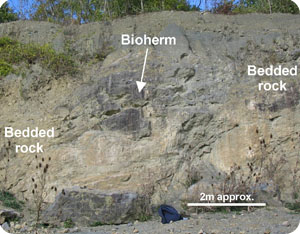
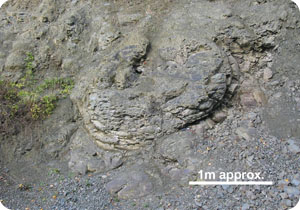
Analysis of the Bentonites
This section gives a more technical description of the work on the bentonites. Nine bentonite horizons have been identified in the Coalbrookdale and Much Wenlock Limestone Formations (Wenlock age) from Whitman's Hill Quarry. A heavy mineral study on the crystal components of eight of these bentonites has been carried out. The work was done in order (i) to verify that the bentonites have a volcanic origin, (ii) to constrain the nature of their magmatic source, and (iii) to ascertain whether any of the crystal components could be dated in order to determine their age.
The presence of apatite offers the possibility of evaluating the composition of the magmas that sourced the bentonites. Apatite compositions vary depending on the composition of their host rock (Fleischer and Altschuler, 1986). This relationship has been used previously to ascertain the composition of the magmatic source of bentonites. For example, Batchelor and Evans (2004) showed that bentonites in the Ordovician of the Southern Uplands of Scotland were derived from intermediate / mafic magmas.
The presence of zircon offers the opportunity to date the bentonites, since single crystals can be readily dated by U-Pb methods using the sensitive high-resolution ion microprobe (SHRIMP). The zircons in bentonite #1 are euhedral and unabraded, as shown in Fig. 1. The apatites in bentonite #9 are either euhedral prismatic crystals or broken prisms (Fig. 2), both of which lack any evidence for abrasion. The morphology of the zircons and apatites therefore indicates that they represent volcanic material deposited through air-fall processes, rather than terrigenous clastic material. The SEM study therefore verifies the petrographic observations, that the bentonites represent volcanic material and that the crystal components can be used to constrain the nature of the magmatic source and the age of the volcanism.
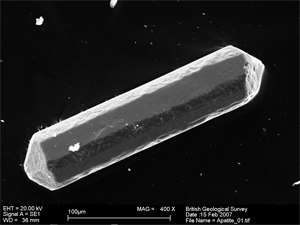

A U-Pb analysis on SHRIMP II for bentonite #2 yielded a preliminary age value of 422.2Ma ± 3.7Ma, which is consistent with the expected depositional age within acceptable tolerances. From the stratigraphy, the date was expected to be close to the Sheinwoodian / Homerian boundary which the ICS gives as 426.2Ma ± 2.3Ma. Interestingly, there are three older zircons (c.460Ma) which must represent wall-rock contamination. The relatively high spread of data is likely to be because of cracking in the zircons, as revealed by cathodoluminescence analysis, which leads to loss of radiogenic Pb from the lattice.
Results of subsequent U-Pb analyses on SHRIMP II for bentonite #1 showed an age of 421.3Ma ± 4Ma, which is again consistent with the expected depositional age, within acceptable tolerances.
Evidence from apatite and zircon morphologies provides strong evidence for a volcanic origin for the bentonites in the Coalbrookdale and Much Wenlock Limestone Formations. Variations in abundance of apatite and zircon suggest changes in magma composition with time. Zircon is common only in the earliest two bentonites, whereas apatite is scarce in the lower part of the succession but becomes more abundant higher in the succession. Geochemical evidence on apatite provides further support for changes in magma composition.
Variations in La/Nd and (La+Ce+Pr)/ΣREE indicate that bentonites #4, #6 and #7 have acidic character and that #9 has intermediate/mafic character. Ce/Y ratios indicate that #9 has more alkaline tendencies compared with #4, #6 and #7. Radiometric age data for bentonites #1 and #2 are consistent with the expected depositional age. Both bentonite ages are slightly young compared with their stratigraphic age, although both ages do fall within error of their age on the currently accepted time scale.
References
- Batchelor, R.A. and Evans, J., 2004. Rare earth element and Sr-Nd isotope geochemistry of primary apatite crystals in metabentonites from Dob’s Linn, southern Scotland. Scottish Journal of Geology, 40, 43-48.
- Fleischer, M. and Altschuler, Z.S., 1986. The lanthanides and yttrium in minerals of the apatite group – an analysis of the available data. Neues Jahrbuch Mineralogische Monatschefte, 10, 467-480.
- The Whitman's Hill dating work (using Zircons) was performed using the Sensitive High Resolution Ion Micro-Probe (SHRIMP) at Australian National University.
- The work to establish the nature of the volcanic activity that generated the bentonites using Apatite was performed Bristol University's Laser Ablation Inductively Coupled Plasma Mass Spectrometer (LA-ICP-MS).

